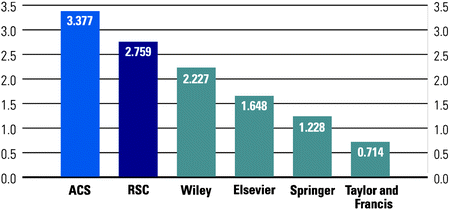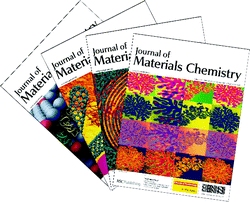New developments in Journal of Materials Chemistry
Abstract
Fred Wudl has been appointed Associate Editor for the USA. Journal of Materials Chemistry now benefits from a number of advanced web developments: RSS Feeds and Forward Linking. Read more in this Editorial, including a list of our top 10 articles for 2005.
2005 was a year of celebration for Journal of Materials Chemistry. The year began with a special issue celebrating the journal's 15th year of publication and ended with a reception at the Fall MRS Meeting in Boston, which marked the appointment of our new Associate Editor for North America, Fred Wudl. In 2005 we also celebrated becoming the first weekly materials journal. The journal has gone from strength to strength over the last year and we are continuing to innovate in 2006.
Associate Editor for North America
We are pleased to welcome Professor Fred Wudl to the position of Associate Editor for North America. Fred will represent the journal in North American and handle a small number of articles. Articles from North America will also be handled by staff at the International Editorial Office in Cambridge, UK.Fred would like to receive the best and most exciting new research in materials from North America. He will be attending a number of conferences over the next year and looks forward to meeting you to discuss publishing with the journal.
Fastest publication in the field
Communications are now published in only 50 days from receipt and full papers in only 80 days, making the journal the fastest place to publish your high-impact research. Earlier this year, we were pleased to have published a full paper in only 18 days from receipt to publication.1 The move to weekly publication has been very positive and brought articles to readers’ attention even faster. Thanks are due to our dedicated Editorial and Production staff in the Editorial Office. | ||
| Fig. 1 Publication times in Journal of Materials Chemistry. | ||
Review articles
Weekly publication has enabled us to publish a greater number of review articles than before, helping to make the journal essential reading for all materials researchers. Each issue of the journal contains at least one review. For a comprehensive list see http://www.rsc.org/materials and follow the link to our Review articles page. We publish three different types of review article and this issue contains examples of each: there are Feature Articles from Fraser Stoddart and Harald Hoppe, an Application from Maria Vallet-Regí and a Highlight by Luis Liz-Marzán.A number of our reviews can be found in the two guest editor issues we published in 2005 on Fluorescent Sensors2 and Functional Hybrid Materials.3 These issues provide a comprehensive overview of the area and have been warmly welcomed by their respective communities.
Upcoming themed issues for later this year include guest-editor issues from Dante Gatteschi and Eugenio Coronado on Molecular Magnetic Materials and one- and two-dimensional nanomaterials with guest editor Luis Liz-Marzán.
Cover artwork
Journal of Materials Chemistry will continue to highlight authors' work on both the outside and inside covers of the journal. 2005 saw some very striking designs in the new journal format, some of which you can see below. We will continue these throughout 2006 with even more inside covers, highlighting our best papers. All our journal covers can be seen on our website; take a look at some of the stunning designs we've had this year at http://www.rsc.org/materials.We welcome suggestions for cover artwork from authors wishing to highlight their work on the journal's covers; please contact the Editorial Office for more details.
Increasing impact
The 2004 impact factors, released by ISI® in June 2005, showed an impressive average increase of over 10% for RSC journals.Calculated annually, ISI® impact factors provide an indication of the quality of a journal—they take into account the number of citations in a given year for all the citeable documents published within a journal in the preceding two years. It is worth noting that alongside the ACS Publications, journals from RSC Publishing have the highest median impact factor among publishers in the chemical sciences. This encouraging statistic demonstrates the recognition and status that researchers place in society published work.
 | ||
| Fig. 2 Median impact factors in 7 ISI® core chemistry categories. | ||
Journal of Materials Chemistry publishes exciting, current research and the immediacy of the work published is increasing as shown by our latest immediacy index (see Fig. 3).4
Like the impact factor, the immediacy index is a statistic released by ISI® that gives a measure of how articles are cited after publication. The immediacy index describes the frequency that articles published in a journal are cited within the same year, i.e. the immediacy of their presence in citations in the literature.
The immediacy index of Journal of Materials Chemistry has increased greatly in 2004, indicating the increased impact and profile of the journal.
 | ||
| Fig. 3 Immediacy indices of materials journals. | ||
New board members
We thank retiring Board members Duncan Bruce, M. Saiful Islam, Paul Smith and William S. Rees for all their hard work during their terms of office. In particular we would like to thank Will Rees for his outstanding work as Associate Editor for North America.We welcome four new Editorial Board members: Cameron Alexander (Nottingham, UK), John Irvine (St Andrews, UK), Carsten Tschierske (Halle, Germany) and Fred Wudl (University of California) who joins the Board as Associate Editor for North America. Profiles of Cameron Alexander, John Irvine and Carsten Tschierske are published later in this issue.
Soft Matter
We hope you are enjoying receiving the RSC's new monthly journal Soft Matter, launched in 2005.5 Subscribers to Journal of Materials Chemistry will continue to receive free print and online access to Soft Matter in 2006.Web site developments
2005 has seen RSC Publishing invest significantly in technological developments across all of its products. First there was the introduction of the new website in the summer which included a contemporary, fresh look and an enhanced structure for improved and intuitive navigation between relevant, associated content. The improvements to the technological infrastructure have made the site more flexible and efficient, and better equip the RSC to deliver enhanced publishing products and services for its customers in the future. The new look was just the start and towards the end of the year we were pleased to provide further enhancements in the form of RSS feeds and ‘forward linking’ facilities.RSS feeds
RSS, or ‘really simple syndication’, is the latest way to keep up with the research published by the RSC. The new service provides subscribers with alerts as soon as an Advance Article is published in their journal of choice. Journal readers simply need to go to the journal homepage, click on the RSS link, and follow the step-by-step instructions to register for these enhanced alerts. RSS feeds include both the graphical abstract and text from a journal's contents page—i.e. they deliver access to new research straight to a readers' PC, as soon as it is published! Many feed reader software packages also have the added benefit of remembering what has been read previously, which in turn makes tracking and managing journal browsing more efficient.| Top accessed articles from our web site |
|---|
| Applications of hybrid organic–inorganic nanocomposites |
| Clément Sanchez, Beatriz Julián, Philippe Belleville and Michael Popall, J. Mater. Chem., 2005, 15, 3559 |
| Synthetic polymers as drugs and therapeutics |
| Beverley Twaites, Carolina de las Heras Alarcón and Cameron Alexander, J. Mater. Chem., 2005, 15, 441 |
| Possible exploitation of magnetic nanoparticle–cell interaction for biomedical applications |
| Catherine C. Berry, J. Mater. Chem., 2005, 15, 543 |
| Synthesis of replica mesostructures by the nanocasting strategy |
| Haifeng Yang and Dongyuan Zhao, J. Mater. Chem., 2005, 15, 1217 |
| Electrospinning of nanofibers with core-sheath, hollow, or porous structures |
| Jesse T. McCann, Dan Li and Younan Xia, J. Mater. Chem., 2005, 15, 735 |
| Scientific importance, properties and growing applications of poly(3,4-ethylenedioxythiophene) |
| Stephan Kirchmeyer and Knud Reuter, J. Mater. Chem., 2005, 15, 2077 |
| 3,4-Ethylenedioxythiophene (EDOT) as a versatile building block for advanced functional π-conjugated systems |
| Jean Roncali, Philippe Blanchard and Pierre Frère, J. Mater. Chem., 2005, 15, 1589 |
| Self-assembled nanoarchitectures of polar nanobelts/nanowires |
| Zhong Lin Wang, J. Mater. Chem., 2005, 15, 1021 |
| Carbon nanotube thin films with ordered structures |
| Chunsheng Du, Jeff Yeh and Ning Pan, J. Mater. Chem., 2005, 15, 548 |
| Iron oxide–gold core–shell nanoparticles and thin film assembly |
| Lingyan Wang, Jin Luo, Mathew M. Maye, Quan Fan, Qiang Rendeng, Mark H. Engelhard, Chongmin Wang, Yuehe Lin and Chuan-Jian Zhong, J. Mater. Chem., 2005, 15, 1821 |
Forward linking
‘Forward linking’, the reverse of reference linking, enables readers to link from any RSC published paper to the articles in which it is cited. In essence, it allows researchers to easily track the progression of a concept or discovery, since its original publication. With one click of a button (on the ‘search for citing articles’ link) a list of citing articles included in CrossRef is presented, complete with DOI links.At a time when research is becoming increasingly interdisciplinary in nature and the amount of published works continues to grow, it is hoped that the new technology, developed in conjunction with CrossRef, will significantly reduce the time spent by researchers searching for information.
These developments demonstrate the investment in publishing products and services over the past year and 2006 will see us enhancing our products further, with improvements to the HTML functionality of all journals and ReSourCe (the author and referee web interface) already under way.
Books
Not just journals…
As well as an impressive portfolio of prestigious journals, the RSC has a significant collection of book titles. The first titles in three new series: RSC Biomolecular Sciences; RSC Nanoscience & Nanotechnology Series; and Issues in Toxicology, were published in 2005, with further titles due during 2006. Future growth in the books publishing programme is planned, which reflects the increasingly interdisciplinary nature of the chemical sciences.Thank you
Finally, we would like to express our thanks to everyone who has contributed to the journal over the last year; all the authors who have submitted excellent papers and referees who have provided fast and informed reviews. It is to the credit of the authors and referees that we have a journal of such high quality of which we can all be proud.We hope that you continue to enjoy reading the journal in 2006. If you have any comments or suggestions about the journal, we would be delighted to hear from you at the Editorial Office.
On behalf of the Editorial Board and the Editorial Staff we wish you all a very happy and successful 2006.
 | ||
| Plate1 Maurizio Prato, Chairman Editorial Board | ||
 | ||
| Plate2 Graham McCann, Editor | ||
 | ||
| Plate3 Sophia Anderton, Deputy Editor | ||
References
- G. G. Wildgoose, N. S. Lawrence, H. C. Leventis, J. Li, T. G. J. Jones and R. G. Compton, J. Mater. Chem., 2005, 15, 953 RSC.
- A. P. de Silva and P. Tecilla, J. Mater. Chem., 2005, 15, 2637 RSC.
- C. Sanchez, J. Mater. Chem., 2005, 15, 3557 RSC.
- http://jcrweb.com/www/help/hjcr_q4.htm.
- U. Steiner and C. Stanier, Soft Matter, 2005, 1, 11 RSC.
| This journal is © The Royal Society of Chemistry 2006 |



